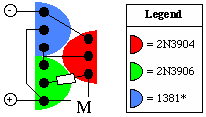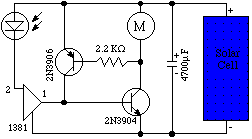|
|
The BEAM Circuits Collection is a BEAM Reference Library site.
The 1381-based solar engine
Using a 1381 voltage
detector
The 1381 solar engine uses a 1381* voltage detector (a.k.a., a voltage supervisor) IC to drive a voltage-based (type 1) solar engine. The 1381 is normally used to reset CPUs and Micros when the power supply drops too low for reliable operation. So 1381s detect and switch when the input voltage crosses the rated upper and lower threshold voltages. The upper- and lower-switching voltages are slightly overlapped so that the turn-on voltage is a few hundred mV above the turn-off voltage. This hysteresis keeps input noise (around the switching threshold) from resulting in multiple output cycles as the transition occurs.
The 1381 SE is designed to increase the 1381 hysteresis from 0.2 - 0.3 V to a much larger value (2 - 4.6 V). This is done by essentially dropping the turn-off voltage to zero, while allowing SE to "fire" at the 1381's rated turn-on voltage.
Here's the basic circuit:

How it works
As the solar
cell charges the (4700 uF) storage
capacitor, the voltage across the capacitor
increases with time. Eventually it reaches the 1381's
trip point, and the 1381
applies voltage to the base
of the 2N3904.
Since this is an NPN
transistor,
it "trips" and applies current to the motor. Meanwhile, it
has brought the base
of the 2N3906
"low," which causes it to conduct to the 2N3904's
base
as well (so at this point, the 1381
is essentially out of the circuit).
This state of affairs will continue until the capacitor
is fully drained, at which point the 2N3906
and 2N3904
both go "quiescent," and the solar
cell resumes charging the capacitor.
|
|
|||
|
|
|
|
|
|
Storage capacitor |
|
|
|
|
|
|
|
|
|
|
|
|
|
|
|
|
|
|
|
2.2 KOhm Resistor |
|||
You can "tweak" the performance of the SE by adjusting the value of the resistor:
- Increase the size of the resistor
for longer running time (generally more-efficient), but
lower starting torque
- Decrease the size of the resistor for shorter running time, but higher starting torque
|
If you want to build a "freeform" version of this circuit, here's a very compact layout (note that the layout shows the transistors and 1381 in "dead-bug" fashion, i.e., with their legs pointing towards you). You should start by glueing the transistors and 1381 together. As is usual for things this small, you should then solder your connections starting in the middle (i.e., work your way out). |
 |
Circuit variants
You can also build a variant of this circuit with a
photodiode
to provide light sensitivity:

This version of the circuit is often used in pairs in photopoppers.
|
|
|
If this page just doesn't whet your appetite for
1381-based
solar engine designs, you ought to check out the
Miller solar engine
and VTSE pages. |
|
|
||
|
|
This page was last updated on |
|